Hawler Medical University College of Medicine Department: Surgery

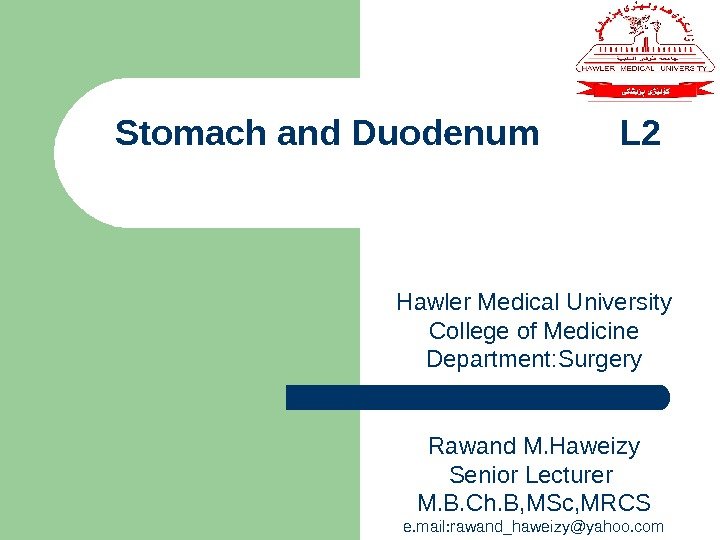
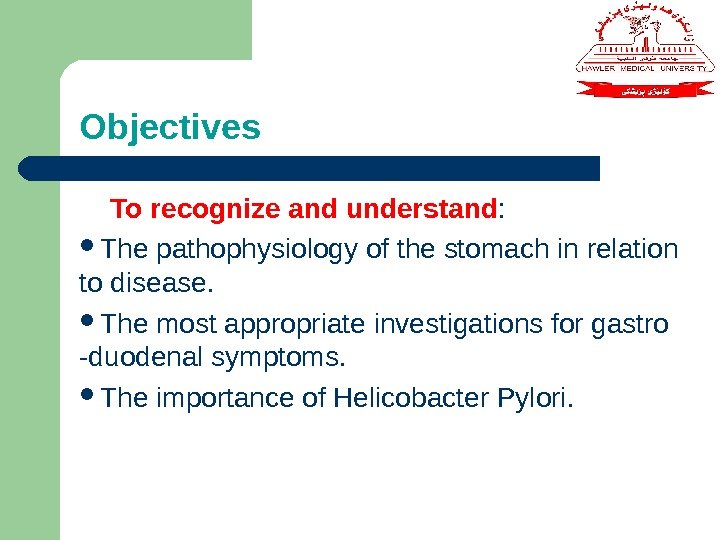
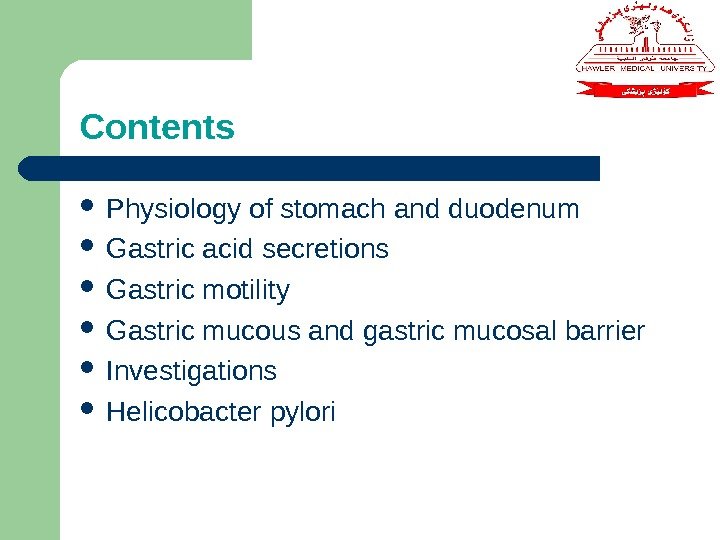
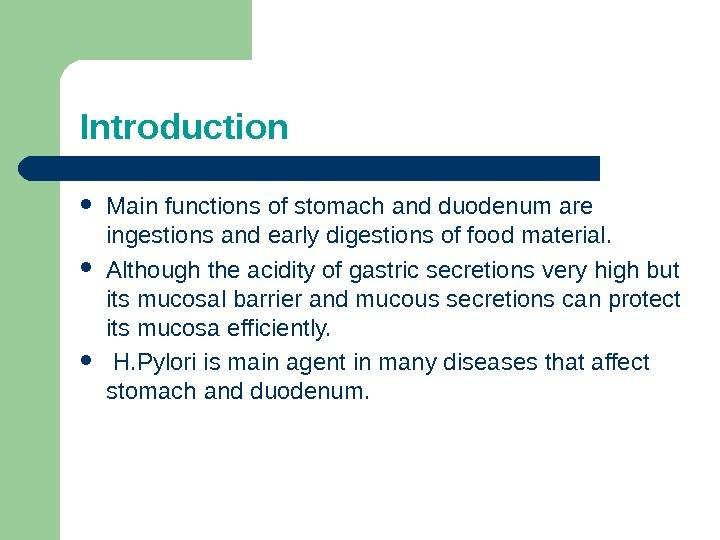
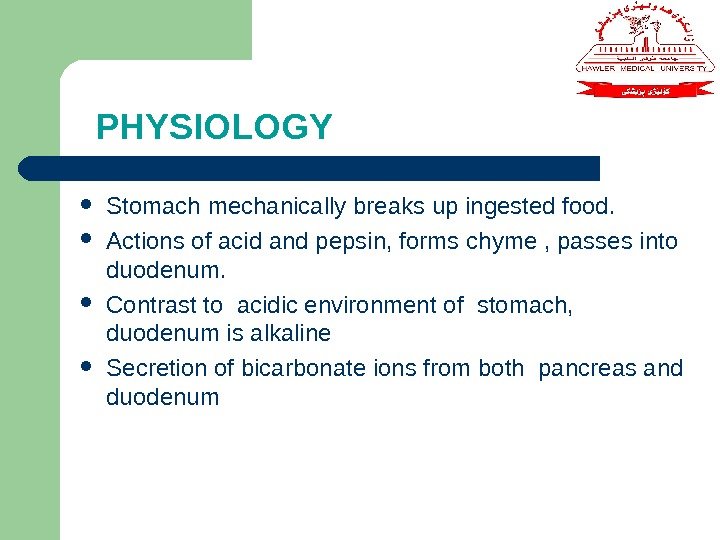
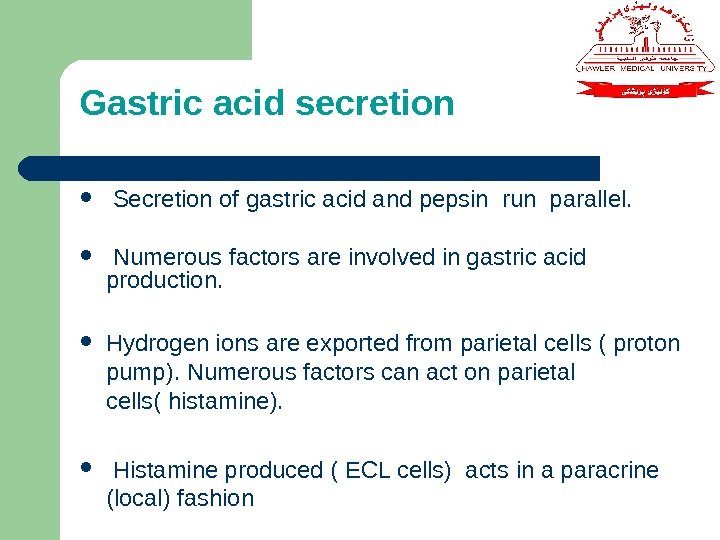
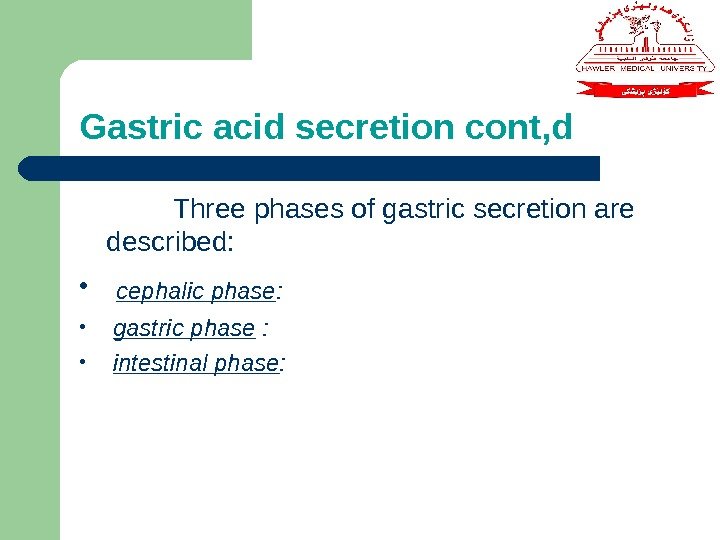
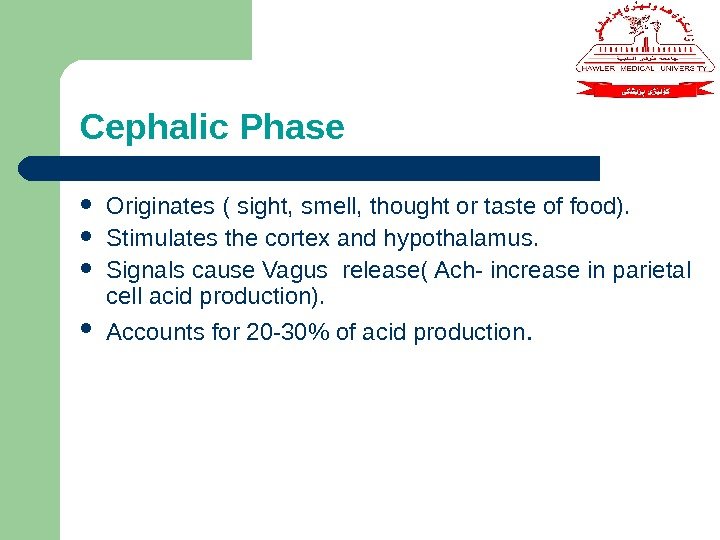
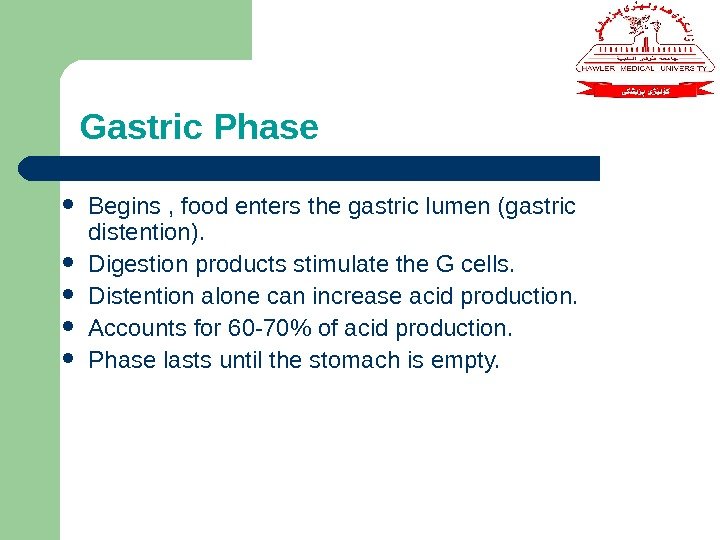
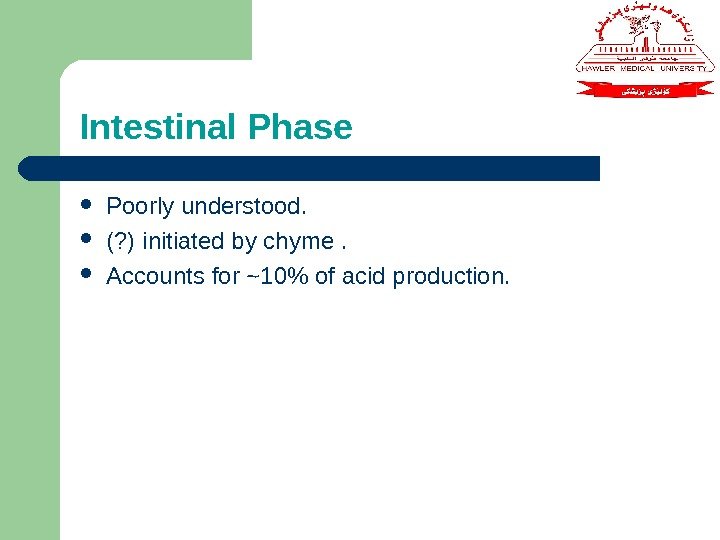
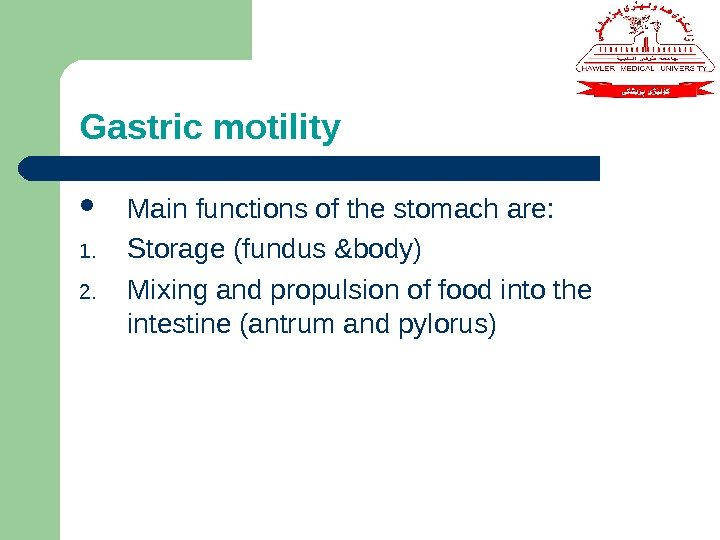
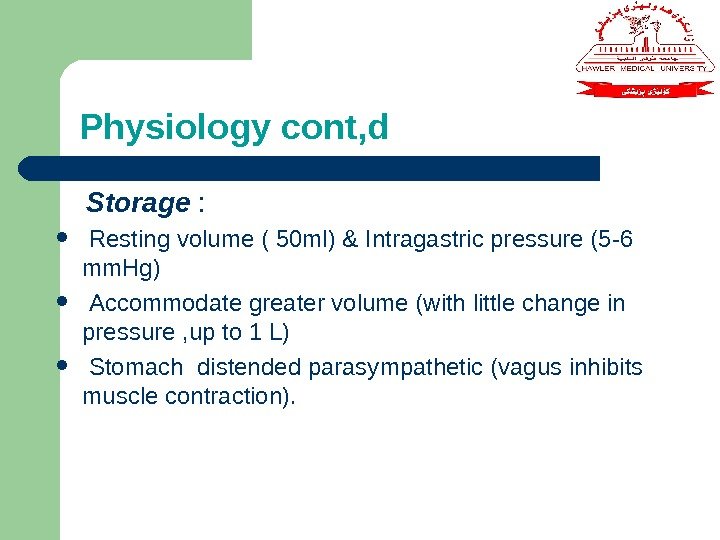
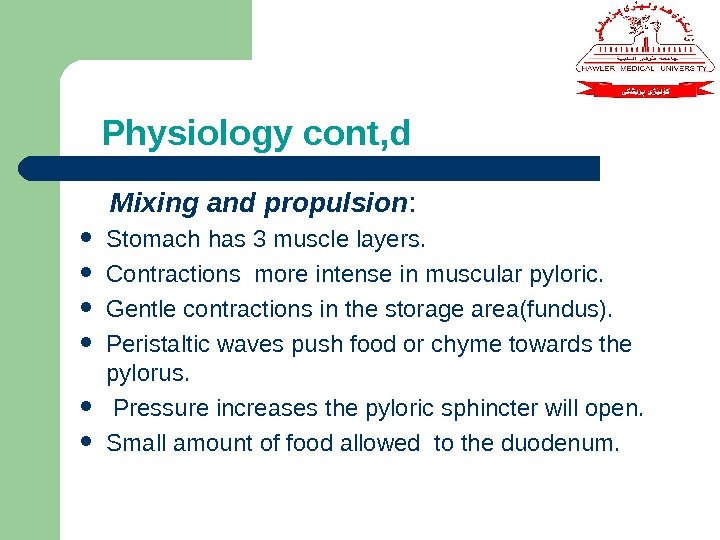
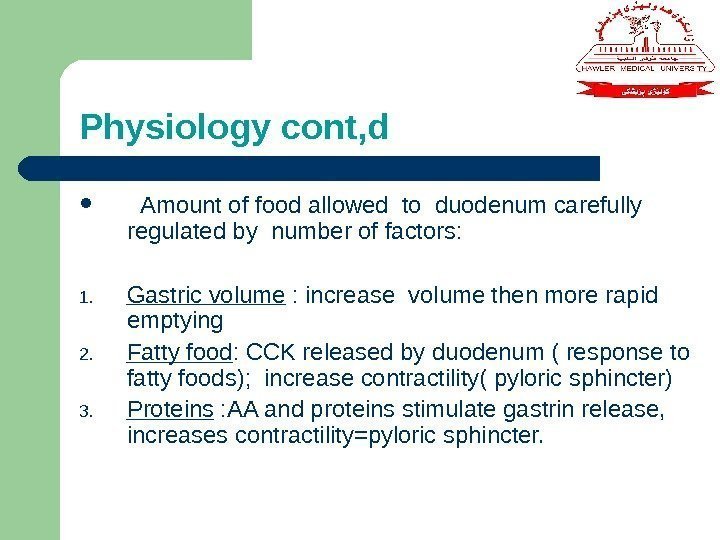
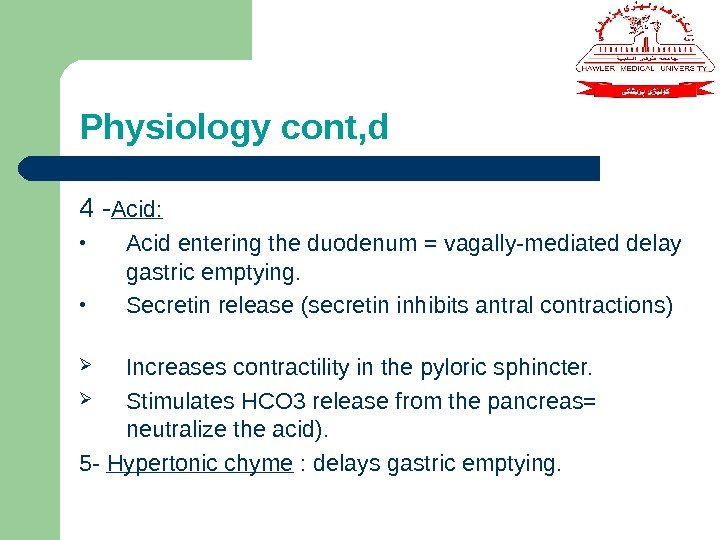
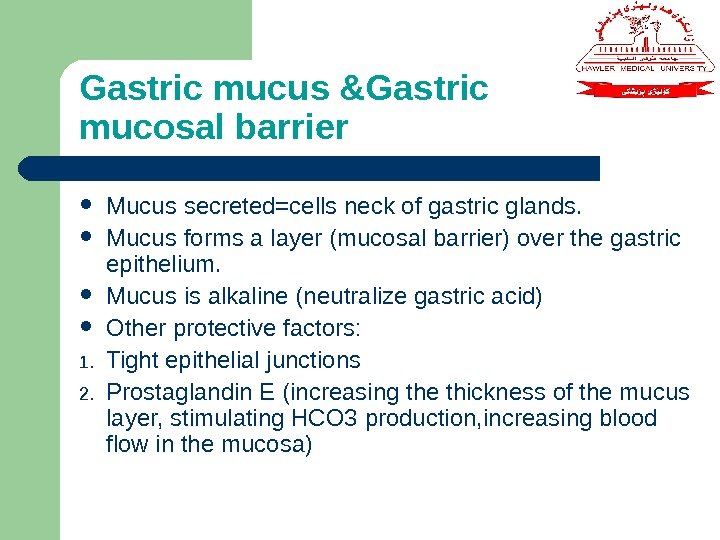
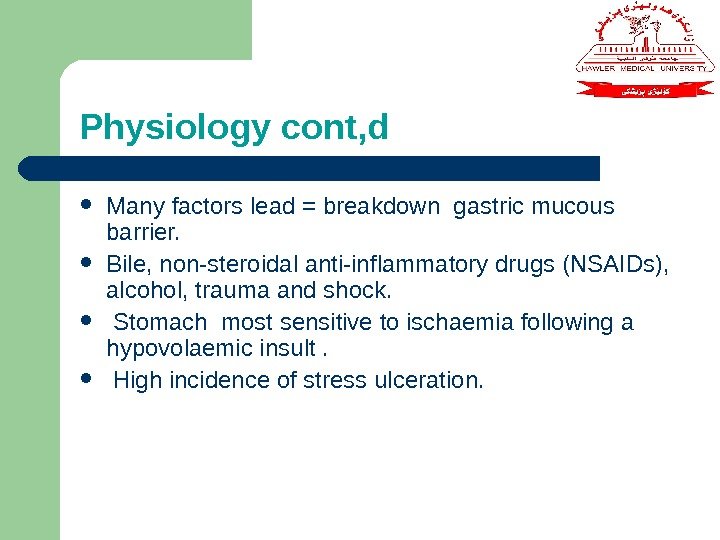

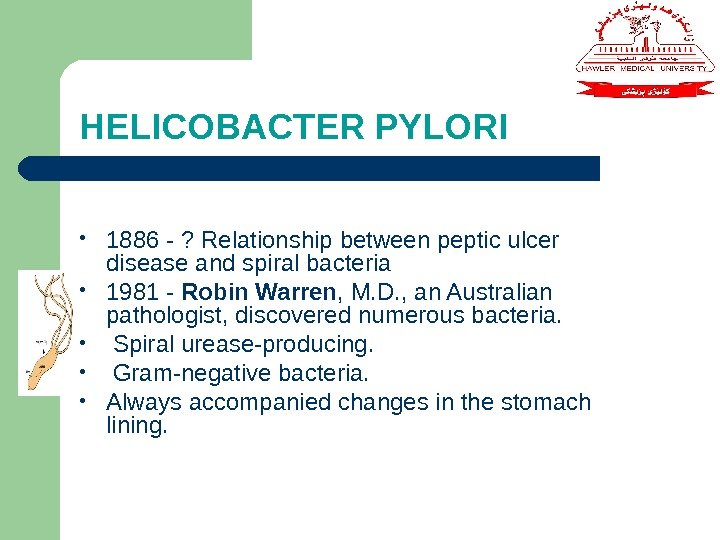
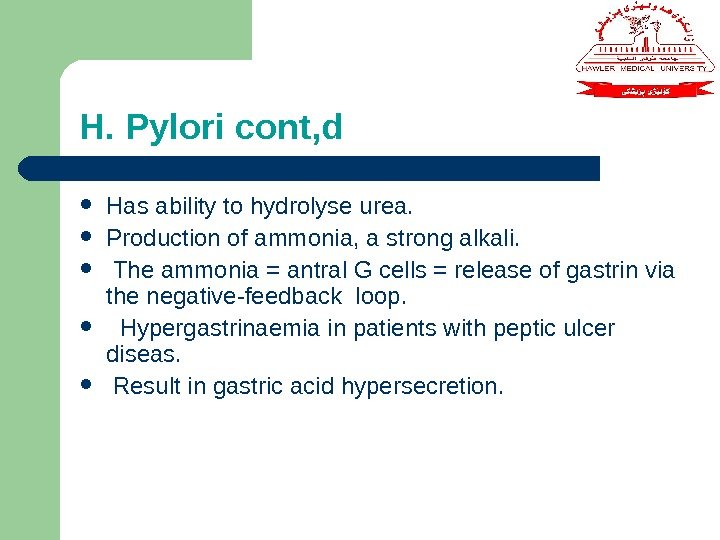
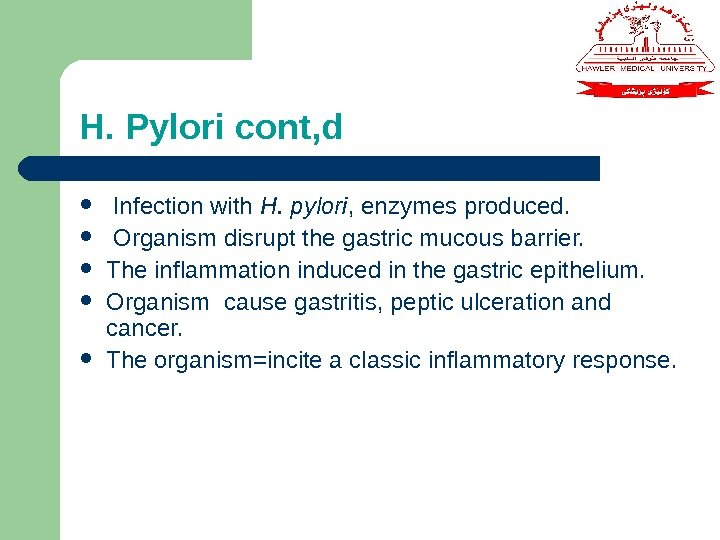
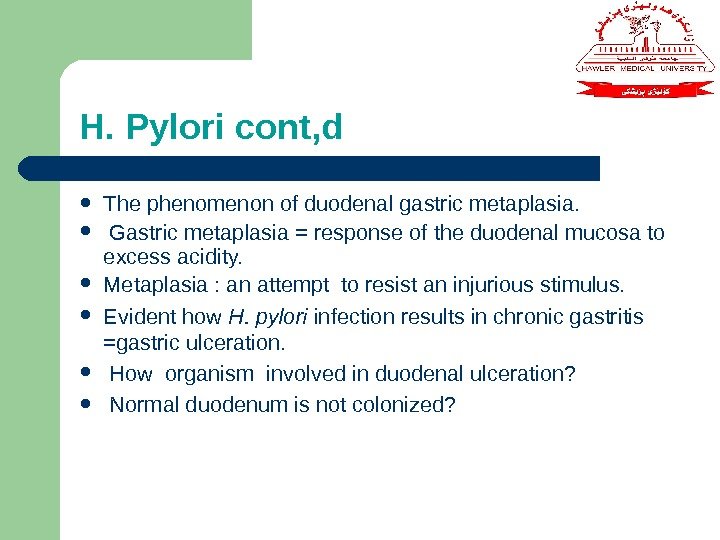
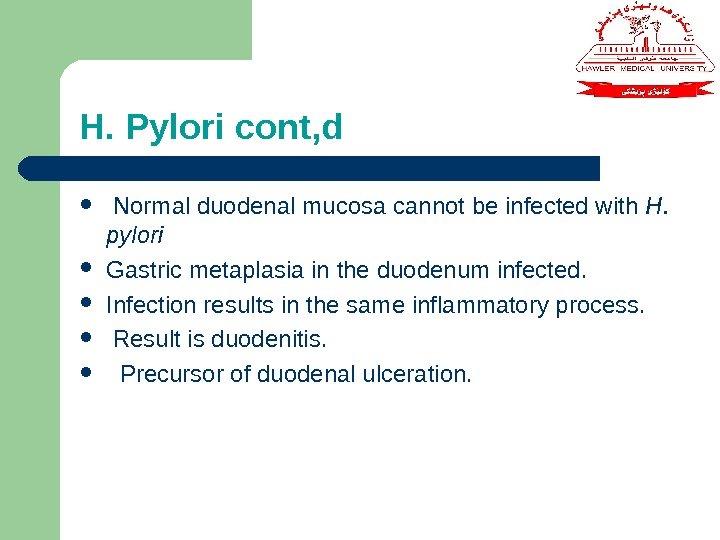

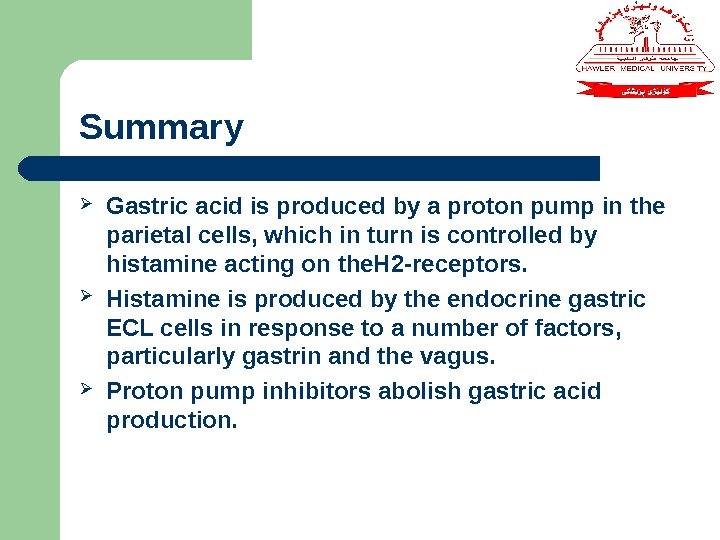
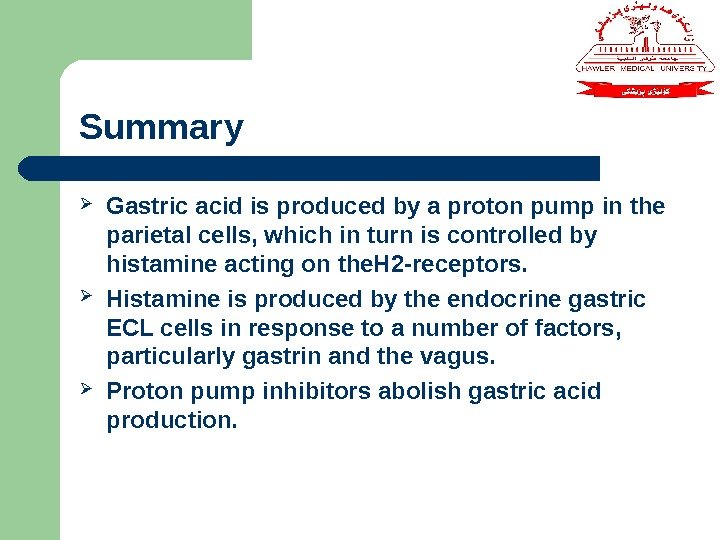
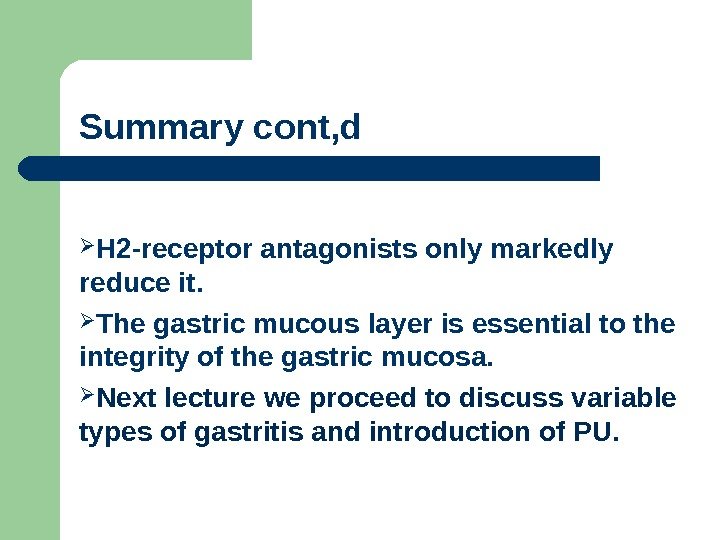
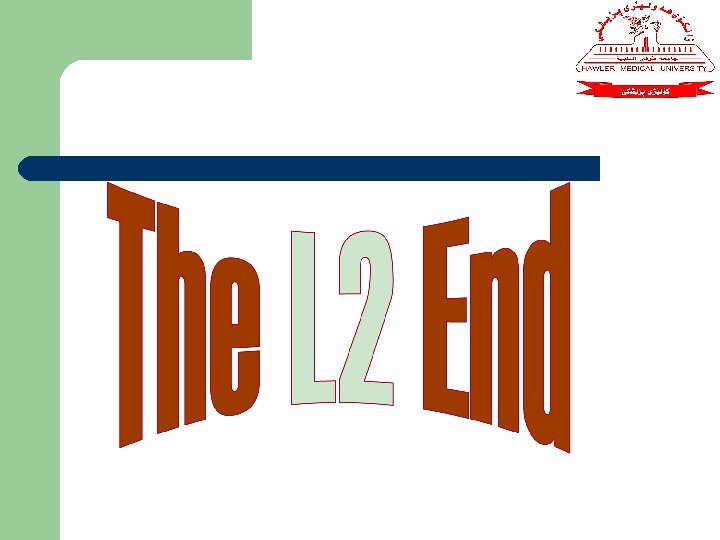
l2.ppt
- Размер: 358.0 Кб
- Автор:
- Количество слайдов: 28
Описание презентации Hawler Medical University College of Medicine Department: Surgery по слайдам
 Hawler Medical University College of Medicine Department: Surgery Rawand M. Haweizy Senior Lecturer M. B. Ch. B, MSc, MRCS e. mail: rawand_haweizy@yahoo. com. Stomach and Duodenum L
Hawler Medical University College of Medicine Department: Surgery Rawand M. Haweizy Senior Lecturer M. B. Ch. B, MSc, MRCS e. mail: rawand_haweizy@yahoo. com. Stomach and Duodenum L
 Objectives To recognize and understand : The pathophysiology of the stomach in relation to disease. The most appropriate investigations for gastro -duodenal symptoms. The importance of Helicobacter Pylori.
Objectives To recognize and understand : The pathophysiology of the stomach in relation to disease. The most appropriate investigations for gastro -duodenal symptoms. The importance of Helicobacter Pylori.
 Contents Physiology of stomach and duodenum Gastric acid secretions Gastric motility Gastric mucous and gastric mucosal barrier Investigations Helicobacter pylori
Contents Physiology of stomach and duodenum Gastric acid secretions Gastric motility Gastric mucous and gastric mucosal barrier Investigations Helicobacter pylori
 Introduction Main functions of stomach and duodenum are ingestions and early digestions of food material. Although the acidity of gastric secretions very high but its mucosal barrier and mucous secretions can protect its mucosa efficiently. H. Pylori is main agent in many diseases that affect stomach and duodenum.
Introduction Main functions of stomach and duodenum are ingestions and early digestions of food material. Although the acidity of gastric secretions very high but its mucosal barrier and mucous secretions can protect its mucosa efficiently. H. Pylori is main agent in many diseases that affect stomach and duodenum.
 PHYSIOLOGY Stomach mechanically breaks up ingested food. Actions of acid and pepsin, forms chyme , passes into duodenum. Contrast to acidic environment of stomach, duodenum is alkaline Secretion of bicarbonate ions from both pancreas and duodenum
PHYSIOLOGY Stomach mechanically breaks up ingested food. Actions of acid and pepsin, forms chyme , passes into duodenum. Contrast to acidic environment of stomach, duodenum is alkaline Secretion of bicarbonate ions from both pancreas and duodenum
 Gastric acid secretion Secretion of gastric acid and pepsin run parallel. Numerous factors are involved in gastric acid production. Hydrogen ions are exported from parietal cells ( proton pump). Numerous factors can act on parietal cells( histamine). Histamine produced ( ECL cells) acts in a paracrine (local) fashion
Gastric acid secretion Secretion of gastric acid and pepsin run parallel. Numerous factors are involved in gastric acid production. Hydrogen ions are exported from parietal cells ( proton pump). Numerous factors can act on parietal cells( histamine). Histamine produced ( ECL cells) acts in a paracrine (local) fashion
 Gastric acid secretion cont, d Three phases of gastric secretion are described: • cephalic phase : • gastric phase : • intestinal phase :
Gastric acid secretion cont, d Three phases of gastric secretion are described: • cephalic phase : • gastric phase : • intestinal phase :
 Cephalic Phase Originates ( sight, smell, thought or taste of food). Stimulates the cortex and hypothalamus. Signals cause Vagus release( Ach- increase in parietal cell acid production). Accounts for 20 -30% of acid production.
Cephalic Phase Originates ( sight, smell, thought or taste of food). Stimulates the cortex and hypothalamus. Signals cause Vagus release( Ach- increase in parietal cell acid production). Accounts for 20 -30% of acid production.
 Gastric Phase Begins , food enters the gastric lumen (gastric distention). Digestion products stimulate the G cells. Distention alone can increase acid production. Accounts for 60 -70% of acid production. Phase lasts until the stomach is empty.
Gastric Phase Begins , food enters the gastric lumen (gastric distention). Digestion products stimulate the G cells. Distention alone can increase acid production. Accounts for 60 -70% of acid production. Phase lasts until the stomach is empty.
 Intestinal Phase Poorly understood. (? ) initiated by chyme. Accounts for ~10% of acid production.
Intestinal Phase Poorly understood. (? ) initiated by chyme. Accounts for ~10% of acid production.
 Gastric motility Main functions of the stomach are: 1. Storage (fundus &body) 2. Mixing and propulsion of food into the intestine (antrum and pylorus)
Gastric motility Main functions of the stomach are: 1. Storage (fundus &body) 2. Mixing and propulsion of food into the intestine (antrum and pylorus)
 Physiology cont, d Storage : Resting volume ( 50 ml) & Intragastric pressure (5 -6 mm. Hg) Accommodate greater volume (with little change in pressure , up to 1 L) Stomach distended parasympathetic (vagus inhibits muscle contraction).
Physiology cont, d Storage : Resting volume ( 50 ml) & Intragastric pressure (5 -6 mm. Hg) Accommodate greater volume (with little change in pressure , up to 1 L) Stomach distended parasympathetic (vagus inhibits muscle contraction).
 Physiology cont, d Mixing and propulsion : Stomach has 3 muscle layers. Contractions more intense in muscular pyloric. Gentle contractions in the storage area(fundus). Peristaltic waves push food or chyme towards the pylorus. Pressure increases the pyloric sphincter will open. Small amount of food allowed to the duodenum.
Physiology cont, d Mixing and propulsion : Stomach has 3 muscle layers. Contractions more intense in muscular pyloric. Gentle contractions in the storage area(fundus). Peristaltic waves push food or chyme towards the pylorus. Pressure increases the pyloric sphincter will open. Small amount of food allowed to the duodenum.
 Physiology cont, d Amount of food allowed to duodenum carefully regulated by number of factors: 1. Gastric volume : increase volume then more rapid emptying 2. Fatty food : CCK released by duodenum ( response to fatty foods); increase contractility( pyloric sphincter) 3. Proteins : AA and proteins stimulate gastrin release, increases contractility=pyloric sphincter.
Physiology cont, d Amount of food allowed to duodenum carefully regulated by number of factors: 1. Gastric volume : increase volume then more rapid emptying 2. Fatty food : CCK released by duodenum ( response to fatty foods); increase contractility( pyloric sphincter) 3. Proteins : AA and proteins stimulate gastrin release, increases contractility=pyloric sphincter.
 Physiology cont, d 4 — Acid: • Acid entering the duodenum = vagally-mediated delay gastric emptying. • Secretin release (secretin inhibits antral contractions) Increases contractility in the pyloric sphincter. Stimulates HCO 3 release from the pancreas= neutralize the acid). 5 — Hypertonic chyme : delays gastric emptying.
Physiology cont, d 4 — Acid: • Acid entering the duodenum = vagally-mediated delay gastric emptying. • Secretin release (secretin inhibits antral contractions) Increases contractility in the pyloric sphincter. Stimulates HCO 3 release from the pancreas= neutralize the acid). 5 — Hypertonic chyme : delays gastric emptying.
 Gastric mucus &Gastric mucosal barrier Mucus secreted=cells neck of gastric glands. Mucus forms a layer (mucosal barrier) over the gastric epithelium. Mucus is alkaline (neutralize gastric acid) Other protective factors: 1. Tight epithelial junctions 2. Prostaglandin E (increasing the thickness of the mucus layer, stimulating HCO 3 production, increasing blood flow in the mucosa)
Gastric mucus &Gastric mucosal barrier Mucus secreted=cells neck of gastric glands. Mucus forms a layer (mucosal barrier) over the gastric epithelium. Mucus is alkaline (neutralize gastric acid) Other protective factors: 1. Tight epithelial junctions 2. Prostaglandin E (increasing the thickness of the mucus layer, stimulating HCO 3 production, increasing blood flow in the mucosa)
 Physiology cont, d Many factors lead = breakdown gastric mucous barrier. Bile, non-steroidal anti-inflammatory drugs (NSAIDs), alcohol, trauma and shock. Stomach most sensitive to ischaemia following a hypovolaemic insult. High incidence of stress ulceration.
Physiology cont, d Many factors lead = breakdown gastric mucous barrier. Bile, non-steroidal anti-inflammatory drugs (NSAIDs), alcohol, trauma and shock. Stomach most sensitive to ischaemia following a hypovolaemic insult. High incidence of stress ulceration.
 INVESTIGATIONS Flexible endoscopy Contrast radiology Ultrasonography Computerised tomography scanning Magnetic resonance imaging Computerised tomography/positron emission Tomography Laparoscopy Gastric emptying studies Angiography
INVESTIGATIONS Flexible endoscopy Contrast radiology Ultrasonography Computerised tomography scanning Magnetic resonance imaging Computerised tomography/positron emission Tomography Laparoscopy Gastric emptying studies Angiography
 HELICOBACTER PYLORI • 1886 — ? Relationship between peptic ulcer disease and spiral bacteria • 1981 — Robin Warren , M. D. , an Australian pathologist, discovered numerous bacteria. • Spiral urease-producing. • Gram-negative bacteria. • Always accompanied changes in the stomach lining.
HELICOBACTER PYLORI • 1886 — ? Relationship between peptic ulcer disease and spiral bacteria • 1981 — Robin Warren , M. D. , an Australian pathologist, discovered numerous bacteria. • Spiral urease-producing. • Gram-negative bacteria. • Always accompanied changes in the stomach lining.
 H. Pylori cont, d Has ability to hydrolyse urea. Production of ammonia, a strong alkali. The ammonia = antral G cells = release of gastrin via the negative-feedback loop. Hypergastrinaemia in patients with peptic ulcer diseas. Result in gastric acid hypersecretion.
H. Pylori cont, d Has ability to hydrolyse urea. Production of ammonia, a strong alkali. The ammonia = antral G cells = release of gastrin via the negative-feedback loop. Hypergastrinaemia in patients with peptic ulcer diseas. Result in gastric acid hypersecretion.
 H. Pylori cont, d Infection with H. pylori , enzymes produced. Organism disrupt the gastric mucous barrier. The inflammation induced in the gastric epithelium. Organism cause gastritis, peptic ulceration and cancer. The organism=incite a classic inflammatory response.
H. Pylori cont, d Infection with H. pylori , enzymes produced. Organism disrupt the gastric mucous barrier. The inflammation induced in the gastric epithelium. Organism cause gastritis, peptic ulceration and cancer. The organism=incite a classic inflammatory response.
 H. Pylori cont, d The phenomenon of duodenal gastric metaplasia. Gastric metaplasia = response of the duodenal mucosa to excess acidity. Metaplasia : an attempt to resist an injurious stimulus. Evident how H. pylori infection results in chronic gastritis =gastric ulceration. How organism involved in duodenal ulceration? Normal duodenum is not colonized?
H. Pylori cont, d The phenomenon of duodenal gastric metaplasia. Gastric metaplasia = response of the duodenal mucosa to excess acidity. Metaplasia : an attempt to resist an injurious stimulus. Evident how H. pylori infection results in chronic gastritis =gastric ulceration. How organism involved in duodenal ulceration? Normal duodenum is not colonized?
 H. Pylori cont, d Normal duodenal mucosa cannot be infected with H. pylori Gastric metaplasia in the duodenum infected. Infection results in the same inflammatory process. Result is duodenitis. Precursor of duodenal ulceration.
H. Pylori cont, d Normal duodenal mucosa cannot be infected with H. pylori Gastric metaplasia in the duodenum infected. Infection results in the same inflammatory process. Result is duodenitis. Precursor of duodenal ulceration.
 Tests designed to detect H. pylori The 13 C and 14 C breath tests. CLO test (urease test kit) performed on gastric biopsies. The organism can also be detected histologically. Previous or current infection detected serologically.
Tests designed to detect H. pylori The 13 C and 14 C breath tests. CLO test (urease test kit) performed on gastric biopsies. The organism can also be detected histologically. Previous or current infection detected serologically.
 Summary Gastric acid is produced by a proton pump in the parietal cells, which in turn is controlled by histamine acting on the. H 2 -receptors. Histamine is produced by the endocrine gastric ECL cells in response to a number of factors, particularly gastrin and the vagus. Proton pump inhibitors abolish gastric acid production.
Summary Gastric acid is produced by a proton pump in the parietal cells, which in turn is controlled by histamine acting on the. H 2 -receptors. Histamine is produced by the endocrine gastric ECL cells in response to a number of factors, particularly gastrin and the vagus. Proton pump inhibitors abolish gastric acid production.
 Summary Gastric acid is produced by a proton pump in the parietal cells, which in turn is controlled by histamine acting on the. H 2 -receptors. Histamine is produced by the endocrine gastric ECL cells in response to a number of factors, particularly gastrin and the vagus. Proton pump inhibitors abolish gastric acid production.
Summary Gastric acid is produced by a proton pump in the parietal cells, which in turn is controlled by histamine acting on the. H 2 -receptors. Histamine is produced by the endocrine gastric ECL cells in response to a number of factors, particularly gastrin and the vagus. Proton pump inhibitors abolish gastric acid production.
 Summary cont, d H 2 -receptor antagonists only markedly reduce it. The gastric mucous layer is essential to the integrity of the gastric mucosa. Next lecture we proceed to discuss variable types of gastritis and introduction of PU.
Summary cont, d H 2 -receptor antagonists only markedly reduce it. The gastric mucous layer is essential to the integrity of the gastric mucosa. Next lecture we proceed to discuss variable types of gastritis and introduction of PU.


